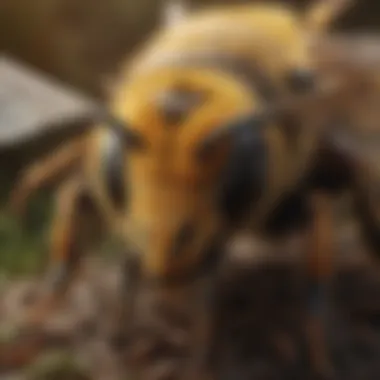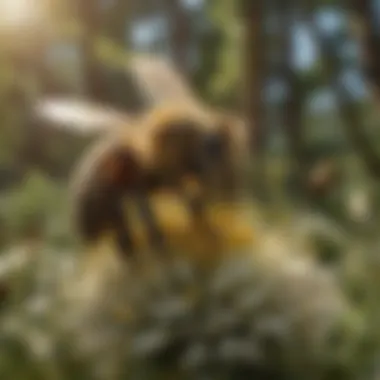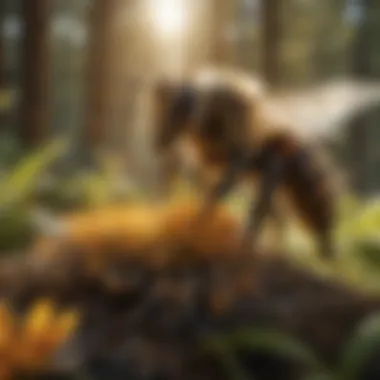Unveiling the Complexity of Bees in Ecosystem Dynamics


Evergreen Trees Species
Evergreen trees, a diverse group of tree species with foliage that remains green and functional throughout the year, play a vital role in the ecological landscape. Within American forests, various types of evergreen trees can be found, each contributing uniquely to the ecosystem. These trees, such as pines, firs, and spruces, are key components of forest ecosystems, providing habitat, food, and shelter for numerous species.
The ecological significance of evergreen trees cannot be overstated. They offer crucial benefits including oxygen production, carbon sequestration, and soil stabilization. Evergreens serve as anchors in ecosystems, promoting biodiversity by creating niches for a wide range of flora and fauna to thrive. Their year-round greenery also helps to maintain the aesthetic appeal of forests, attracting visitors and supporting ecotourism.
Conservation practices aimed at protecting and preserving evergreen tree species are essential for maintaining ecosystem balance. Strategies such as reforestation, habitat restoration, and sustainable logging techniques are employed to ensure the longevity of these invaluable arboreal resources. By implementing conservation methods, forest managers and conservationists can safeguard the continued existence of evergreen trees and the vital ecological services they provide.
Introduction to Bees and Ecology
In the realm of ecological studies, the relationship between bees and their surrounding environments holds a significant place. Bees play a crucial role in maintaining biodiversity, pollination processes, and overall ecosystem health. Understanding the intricate dynamics of bees in the ecosystem is vital for appreciating the interconnected nature of various species and their habitats. This article aims to shed light on the essential nature of bees in sustaining ecological balance, highlighting their contributions to the intricate web of life.
The Significance of Bees in Ecology
Pollination as a Vital Ecosystem Service
Pollination is a fundamental ecosystem service provided by bees, enabling the reproduction and propagation of flowering plants. The efficient transfer of pollen from one flower to another by bees is essential for the production of fruits, seeds, and fertile plant populations. This service not only benefits plant species but also contributes to agricultural productivity and landscape diversity. The specialized pollination mechanisms of bees make them indispensable pollinators in various ecosystems, reaffirming their vital role in maintaining floral biodiversity and ecosystem stability.
Role in Biodiversity Maintenance
Bees play a vital role in the maintenance of biodiversity by facilitating the reproduction of diverse plant species through pollination. As bees forage for nectar and pollen, they inadvertently cross-pollinate flowers, leading to genetic diversity within plant populations. This genetic variability is crucial for the resilience of plant communities against environmental changes and challenges. The symbiotic relationship between bees and plants fosters a rich tapestry of flora, supporting intricate food webs and ecological interactions essential for ecosystem health.
Types of Bees Found in Different Ecosystems
Honeybees
Honeybees, known for their complex social structures and efficient foraging behaviors, are prolific pollinators found across various ecosystems. Their ability to communicate through intricate dance movements and collective decision-making processes sets them apart as key contributors to pollination services. The unique feature of honeybees lies in their organized hive systems and division of labor, ensuring the survival and productivity of their colonies. While honeybees offer significant benefits in pollination, challenges such as colony collapse disorder and pesticide exposure threaten their populations, underscoring the need for conservation efforts to protect these invaluable pollinators.
Bumblebees


Bumblebees, characterized by their fuzzy appearance and distinctive buzzing flight patterns, are important pollinators in ecosystems with diverse flowering plants. Their larger bodies and gentle nature make them effective pollinators for crops and wildflowers alike. Bumblebees exhibit a unique form of buzz pollination, where they vibrate their bodies at a specific frequency to release pollen from flowers inaccessible to other pollinators. Despite their valuable contributions to pollination services, bumblebee populations face habitat loss and pesticide exposure, necessitating conservation measures to ensure their continued presence in ecosystems.
Solitary Bees
Solitary bees, as the name suggests, do not form large colony structures like honeybees but play a crucial role in pollination across different ecosystems. With diverse species adapted to varying habitats and plant species, solitary bees exhibit solitary nesting behaviors, where each female bee creates individual nests for her offspring. This decentralized nesting strategy allows for greater dispersal of pollinators and increased plant diversity through efficient cross-pollination. While solitary bees may not gather in large numbers like social bees, their solitary lifestyle contributes significantly to maintaining floral biodiversity and ecosystem resilience.
Ecological Impact of Bees
Bees play a crucial role in the ecosystem, significantly impacting various facets of the environment. Their ecological impact is a cornerstone of this article, shedding light on the intricate relationship between bees and the surrounding biodiversity, pollination processes, and overall ecosystem health. By delving into the ecological impact of bees, we aim to uncover the depth of their influence on sustaining an intricate web of life within ecosystems.
Pollination Process and Its Ecological Significance
Efficiency of Bee Pollination
Bee pollination stands out for its unparalleled efficiency in transferring pollen from one flower to another, facilitating the reproduction of flowering plants. This efficiency not only enhances the reproductive success of plants but also contributes to the overall health and diversity of flora within a given ecosystem. By focusing on the efficiency of bee pollination, we highlight how bees serve as indispensable pollinators, ensuring the continued proliferation of plant species critical to ecosystem functioning. The unique feature of bee pollination lies in its precision and effectiveness, making it a highly sought-after choice in enhancing pollination processes within the context of this article.
Diversity of Plants Supported
The diversity of plants supported by bee pollination is a key indicator of the ecological significance of this process. Bees play a fundamental role in pollinating a wide array of plant species, ranging from crops to wildflowers, thus contributing to the overall biodiversity and ecological balance of their habitats. By exploring the diversity of plants supported through bee pollination, we illuminate the interconnectedness of bees and various plant species, showcasing the breadth of their ecological impact. The unique feature of this aspect lies in the wide range of plant species that bees can effectively pollinate, underscoring their vital role in sustaining diverse plant communities within ecosystems.
Complex Interactions in Bee-Ecosystem Relationships
Dietary Needs and Foraging Behaviors
Understanding the dietary needs and foraging behaviors of bees is essential in unraveling the complex interactions between bees and their surrounding ecosystems. Bees exhibit specific dietary requirements and foraging patterns that dictate their foraging behaviors and food preferences, influencing their interaction with various plant species and environmental resources. By delving into the intricacies of bees' dietary needs and foraging behaviors, we gain insight into the dynamic relationships between bees, plants, and their habitat. The unique feature of this aspect lies in the specialized adaptations of bees to optimize their foraging efficiency, underscoring their significance in ecosystem dynamics.
Nesting Habits and Habitat Preservation
Bee nesting habits and habitat preservation are critical components of bee-ecosystem relationships, shaping the distribution and abundance of bee populations within a given ecosystem. Bees exhibit diverse nesting habits, with some species requiring specific nesting structures or conditions to thrive. By examining bee nesting habits and the importance of habitat preservation, we highlight the essential role of suitable habitats in supporting bee populations and promoting biodiversity. The unique feature of this aspect lies in the delicate balance between nest availability and habitat integrity, underscoring the importance of conservation efforts in safeguarding bee populations and ecosystem stability.
Challenges Faced by Bees in Today's Ecosystems


Bees encounter a myriad of challenges in modern ecosystems, threatening their crucial roles. Understanding these challenges is vital in the conservation efforts to safeguard bee populations and preserve ecological balance. Pesticides and habitat loss significantly impact bee populations, disrupting their foraging behaviors and reproductive success. These challenges highlight the delicate balance between human activities and the natural world, underscoring the urgency for sustainable practices to ensure bee survival and ecosystem health.
Impact of Pesticides and Habitat Loss on Bee Populations
Effects of Pesticide Exposure
Pesticide exposure poses a substantial threat to bee populations, affecting their cognitive abilities, navigation skills, and immune systems. The pervasive use of neonicotinoids and other chemicals in agriculture amplifies the risks to bees, leading to population declines and compromised ecosystem services. Mitigating pesticide effects necessitates comprehensive regulations, alternative pest management strategies, and public awareness to foster bee-friendly environments.
Loss of Floral Resources
The loss of floral resources due to habitat destruction and land-use changes deprives bees of essential nectar and pollen sources for sustenance and reproduction. Fragmentation of native habitats reduces floral diversity, impacting bee nutrition and colony resilience. Restoring floral landscapes through habitat restoration, diverse plantings, and urban greening initiatives is imperative to counteract the detrimental effects of floral resource loss on bee populations.
Climate Change and Its Effects on Bees
Shifts in Flowering Patterns
Climate change induces shifts in flowering phenology, altering the availability of floral resources for bees. Inconsistent blooming periods disrupt bee foraging patterns, exacerbating food scarcity and mismatches with pollination needs. Understanding and tracking flowering trends are vital to adapt conservation efforts and mitigate the impact of climate-induced phenological shifts on bees and plants.
Disruption of Synchronization with Plant Blooms
Climate change disrupts the synchrony between bee foraging activities and plant blooming cycles, leading to mismatches in species interactions and reduced pollination efficiency. Bees face challenges in locating and accessing food sources, compromising their reproductive success and population dynamics. Addressing this synchronization disruption requires interdisciplinary research, habitat connectivity enhancements, and climate-resilient landscape planning to ensure bee-plant mutualisms persist.
Understanding Colony Collapse Disorder
Causes of
Colony Collapse Disorder results from a confluence of factors, including pesticide exposure, pathogens, poor nutrition, and environmental stressors. Varroa mites and viral infections contribute to colony losses, compounding the impacts of pesticide toxicity and forage scarcity. Studying the multifaceted causes of CCD is indispensable in developing sustainable beekeeping practices, integrated pest management, and disease-resistant bee populations.
Implications for Ecosystem Health


The implications of Colony Collapse Disorder extend beyond bee populations, affecting ecosystem stability and food security. Bee declines disrupt pollination dynamics, reducing crop yields, biodiversity, and ecological resilience. Mitigating the repercussions of CCD demands coordinated efforts in habitat conservation, pollinator-friendly plantings, and policy initiatives to safeguard bee populations and mitigate ecological cascades.
Conservation Efforts and Future Directions
In this article, the segment on Conservation Efforts and Future Directions holds immense significance as it sheds light on vital strategies aimed at preserving bee populations and enhancing their habitat. The preservation of bees is crucial for maintaining biodiversity and ensuring the sustainability of ecosystems. Conservation efforts play a pivotal role in safeguarding these pollinators upon which numerous plant species and agricultural crops depend.
Promoting Bee-Friendly Practices
Organic Farming Techniques
Discussing Organic Farming Techniques within the context of bee conservation is paramount. Organic farming minimizes the use of synthetic pesticides and fertilizers, opting for natural alternatives to promote bee health and overall ecological balance. The key characteristic of this approach lies in its promotion of biodiversity and soil health which are essential for sustaining bee populations. Organic farming practices contribute to reducing chemical exposure for bees, thus safeguarding their well-being. However, challenges such as lower yields compared to conventional methods exist but are outweighed by the long-term benefits for bee conservation.
Creation of Pollinator Habitats
The creation of pollinator habitats is a fundamental aspect of bee-friendly practices. Designing and setting up areas specifically tailored to provide food, shelter, and nesting sites for bees contribute significantly to supporting bee populations. The key characteristic of this initiative is its focus on enhancing bee habitats amidst changing landscapes and urbanization. By planting diverse native flora and creating nesting opportunities, pollinator habitats offer bees a conducive environment to thrive. The unique feature of this strategy is the creation of designated safe spaces solely dedicated to bee conservation efforts. While establishing pollinator habitats requires ongoing maintenance and initial resources, the benefits of bolstering bee populations and ensuring pollination services are invaluable.
Research and Innovation in Bee Conservation
Genetic Studies for Bee Health
Exploring Genetic Studies for Bee Health reveals a pioneering approach channeling genetic research to enhance bee immunity and resilience. This method involves studying bee genetics to understand traits that promote survival and adaptation in changing environments. The key characteristic is the genetic insights gained to develop bee populations resistant to diseases and environmental stressors. Genetic studies offer a promising avenue for breeding resilient bee colonies vital for ecosystem health. The unique feature of this approach lies in its potential to address pressing challenges facing bee populations by leveraging genetic diversity. While genetic studies present ethical considerations and the need for regulatory frameworks, their benefits in sustaining bee health are paramount.
Technological Solutions for Monitoring Bee Populations
Delving into Technological Solutions for Monitoring Bee Populations signifies a shift towards innovative techniques for tracking bee populations and behaviors. Utilizing advanced technologies such as drones and sensor networks, this approach enables real-time monitoring of bee activities and population dynamics. The key characteristic of this technological solution is its precision in collecting data on bee foraging patterns, hive conditions, and environmental factors impacting bee health. Technological advancements provide a non-invasive means of understanding bee behavior and response to changing landscapes. The unique feature of this method is its capacity to offer insights into optimal conservation practices based on real-time data, enhancing the efficiency of bee conservation efforts. Despite initial investment costs and technological complexities, the advantages of accurate monitoring and strategic conservation decisions outweigh the challenges, marking a significant step towards proactive bee conservation.
Conclusion
Key Takeaways on Bees in Ecology
Essential Role in Ecosystem Functioning
Delving into the Essential Role in Ecosystem Functioning showcases how bees act as keystone species, influencing the functioning of entire ecosystems. Their unparalleled efficiency in pollination not only sustains plant populations but also supports diverse flora, contributing to overall ecosystem health. The unique feature of bees as pollinators lies in their specialized relationship with flowering plants, ensuring the reproduction and survival of numerous plant species. Emphasizing sustainable bee conservation practices can further enhance ecosystem resilience and biodiversity.
Need for Sustainable Bee Conservation Practices
Highlighting the Need for Sustainable Bee Conservation Practices underscores the critical importance of adopting environmentally friendly approaches to bee management. By promoting organic farming techniques and establishing pollinator habitats, we can create conducive environments for bees to thrive. The key characteristic of sustainable practices lies in their long-term benefits for ecosystem sustainability and agricultural productivity. Implementing effective conservation strategies is essential for mitigating the adverse effects of habitat degradation and ensuring the continued pollination services provided by bees.



